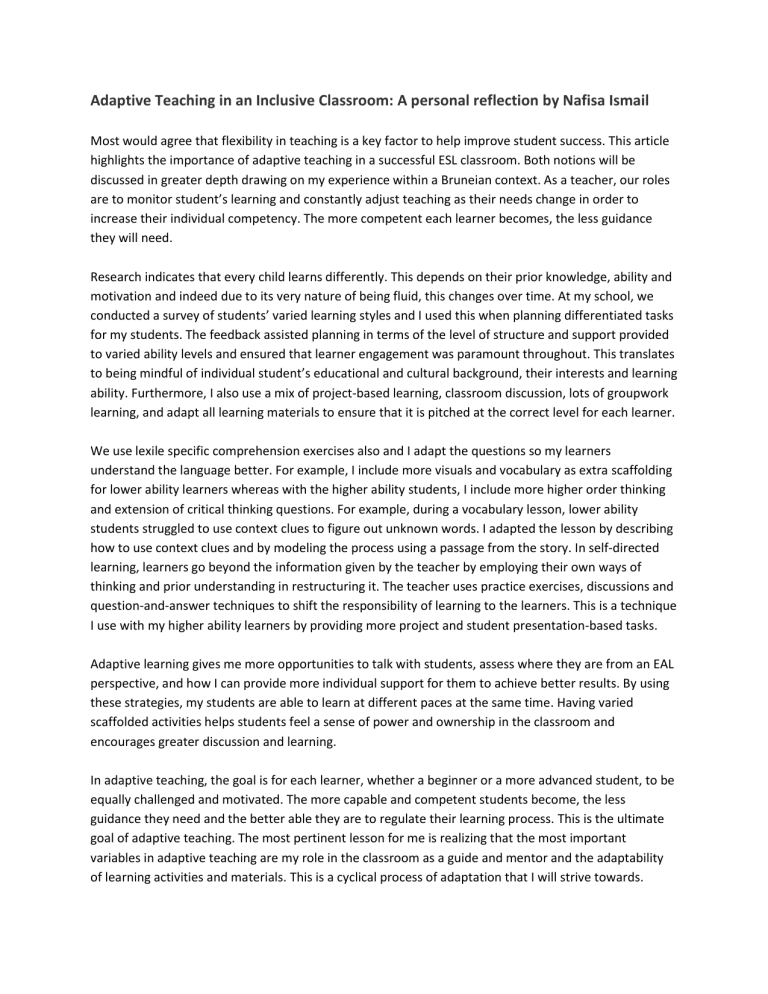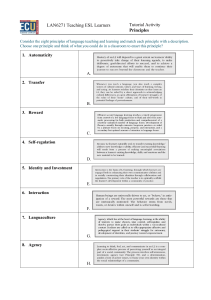
Adaptive Teaching in an Inclusive Classroom: A personal reflection by Nafisa Ismail Most would agree that flexibility in teaching is a key factor to help improve student success. This article highlights the importance of adaptive teaching in a successful ESL classroom. Both notions will be discussed in greater depth drawing on my experience within a Bruneian context. As a teacher, our roles are to monitor student’s learning and constantly adjust teaching as their needs change in order to increase their individual competency. The more competent each learner becomes, the less guidance they will need. Research indicates that every child learns differently. This depends on their prior knowledge, ability and motivation and indeed due to its very nature of being fluid, this changes over time. At my school, we conducted a survey of students’ varied learning styles and I used this when planning differentiated tasks for my students. The feedback assisted planning in terms of the level of structure and support provided to varied ability levels and ensured that learner engagement was paramount throughout. This translates to being mindful of individual student’s educational and cultural background, their interests and learning ability. Furthermore, I also use a mix of project-based learning, classroom discussion, lots of groupwork learning, and adapt all learning materials to ensure that it is pitched at the correct level for each learner. We use lexile specific comprehension exercises also and I adapt the questions so my learners understand the language better. For example, I include more visuals and vocabulary as extra scaffolding for lower ability learners whereas with the higher ability students, I include more higher order thinking and extension of critical thinking questions. For example, during a vocabulary lesson, lower ability students struggled to use context clues to figure out unknown words. I adapted the lesson by describing how to use context clues and by modeling the process using a passage from the story. In self-directed learning, learners go beyond the information given by the teacher by employing their own ways of thinking and prior understanding in restructuring it. The teacher uses practice exercises, discussions and question-and-answer techniques to shift the responsibility of learning to the learners. This is a technique I use with my higher ability learners by providing more project and student presentation-based tasks. Adaptive learning gives me more opportunities to talk with students, assess where they are from an EAL perspective, and how I can provide more individual support for them to achieve better results. By using these strategies, my students are able to learn at different paces at the same time. Having varied scaffolded activities helps students feel a sense of power and ownership in the classroom and encourages greater discussion and learning. In adaptive teaching, the goal is for each learner, whether a beginner or a more advanced student, to be equally challenged and motivated. The more capable and competent students become, the less guidance they need and the better able they are to regulate their learning process. This is the ultimate goal of adaptive teaching. The most pertinent lesson for me is realizing that the most important variables in adaptive teaching are my role in the classroom as a guide and mentor and the adaptability of learning activities and materials. This is a cyclical process of adaptation that I will strive towards. How do we achieve this in a “successful classroom”? By definition, a successful classroom is one where students feel included and appreciated therefore they are more comfortable to contribute in classes. A supportive classroom atmosphere also has to display an appreciation for cultural diversity. One way of doing this is including books in the library corner that enable greater cultural awareness. Students will be more engaged if they feel a personal connection to a topic, hence I try to select topics that are relevant to the Brunei culture and cultural festivals that are happening here. I am thus able to still teach the skills but make it culturally appropriate. This definitely excites my learners and they are also learning relevant vocabulary attached to explaining their particular cultural traditions in English. This further increases the rapport with my ESL learners since they feel that I have taken the time to invest in making the topic fun and relevant. Another strategy important in the class with ESL learners is to definitely speak slowly and increase “wait time” after posing questions. This waiting time gives ESL learners time to think, translate back into English, and feel confident that they have a better thought-out answer. If we rush through questions, learners might feel that they are not ready to answer and hence not volunteer trying to answer. Bilingualism is the goal, of course, not replacement. Here, it is argued that allowing learners to think in their mother tongue is not discouraged since it will be their first line of reference. Furthermore, it is important to build vocabulary since this assists even with the writing process. Teachers can identify not just the vocabulary but also grammar structures that ESL students may not be aware of. I also include KWL charts in my teaching on varied topics and this helps me when planning for future lessons. This helps me elicit background knowledge and then base vocabulary, comprehension and writing tasks as subsequent lessons on a particular topic area. Again, I make it relevant for my ESL learners and cover areas in subsequent lessons if they found it difficult in previous lessons. Repetition helps them learn the vocabulary and grammar better. In terms of improving my learners writing abilities, I include a short writing piece every fortnight based on whatever topic we are doing so that they can get better with practice. I also have now included a peer editing process which makes them more conscious of spelling and grammar rules. Students need repetitive opportunities to develop writing skills to strengthen their communication skills. This also helps my learners constantly revise varied formats of writing, for example, a letter, report, narrative essay etc. and realise their strengths and weaknesses. Peer feedback definitely helps ESL learners and I have witnessed this even with my AfL strategy project undertaken. Hence, I include varied strategies including "think-pair-share" and "circle chats." As Amy Chua quite aptly asked: “Do you know what a foreign accent is? It’s a sign of bravery.” So indeed, let learners feel comfortable to voice themselves in your class as this motivates learning. To me, this constitutes a successful positive learning environment and culture. Let’s be mindful of this in our daily teaching.
